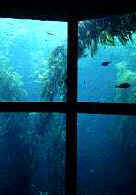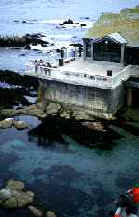TANKS FOR THE MEMORY: MONTEREY'S TERRIFIC AQUARIUM
by Annette LucidoMonterey's Aquarium is arguably one of the best in the US.
Casual visitors miss Monterey Bay's grand canyon. You can't ride mules down to its submerged stygian depths. But you can learn more than a little with a just single visit to Monterey's lovely aquarium.
Nestled among the tourist attractions on the ports' once lively Cannery Row, it concentrates on the underwater and shoreline ecology of this most interesting area.
 As "soft sell" instructional punctuation to the harder pitch common to local shops or as welcome respite to the dangers of overeating so likely in gourmet havens such as Monterey, Carmel and Pacfic Grove the lively museum deserves at least a half-day visit. A plaque at the museum that reads "don't start vast projects with a half vast idea" sets the tone of this most exciting museum.
As "soft sell" instructional punctuation to the harder pitch common to local shops or as welcome respite to the dangers of overeating so likely in gourmet havens such as Monterey, Carmel and Pacfic Grove the lively museum deserves at least a half-day visit. A plaque at the museum that reads "don't start vast projects with a half vast idea" sets the tone of this most exciting museum.
The basic premise formed by marine biologists at Stanford's Hopkins Marine Station of "a self-supporting aquarium on Cannery Row where visitors could learn about the unique ecology of the Monterey Trench and shoreline and researchers could study the area," seems well met. A $40 million gift from David Packard, one of the founders of Hewlett-Packard, set off three years of design and four of construction. This has continued with a massive new section scheduled to open in March of 1996. We can hardly wait.
By concentrating on the unique ecology of the Monterey Trench and shore, you find a focus too often lacking in aquariums that try to cover everything from tropical to artic waters. An understanding of the Monterey Trench's importance to local waters remains central. As one of the deepest submarine canyons in the world it upwells cold, nutrient-rich water just a long drive from shore. This water fuels an explosion of marine growth that packs local tidepools and shallows as well as it pulls in mitratory fish such as salmon.
Such marine abundance attracted indians, Spaniards, Mexican and American explorerers who came in search of gold, land on which to raise cattle for hides and whales respectively. Once threatened persipods such as grey and other whales pass the Monterey Peninsula too. Friendly sea otters and cute harbor seals call its waters home. Elephant seals loll on local beaches. In fact, local waters include at least a dozen unique ecological zones. Each gets its own display at the museum.
However, you won't find shows that feature trained seals or killer whales at the museum. Instead, marine animals and fish swim as freely as possible in their natural surroundings. Perch graze off pilings. Octopi slink across the bottom of their rocky tanks. Salmon and steelhead smolts fin in a stream set on the deck. At the aquarium the show's the fish and mammals. Gaunt, grey walls and unobtrusive floors keep the viewer's attention focused on the exhibits, which break out of the "TV screen on the wall" displays usual in most aquaria.
The most unique exhibit at the Monterey Aquarium must be the 28 foot-high kelp forest tank where massive kelp fronds that grow six inches or more a day wave to the surges of artificial waves produced by a massive cylinder that pounds up and down. This first successful kelp forest now roots strongly on the artificial rocks of the tank's floor. When first installed, only elastic bunge cords held the kelp fast against the churning of over 300,000 gallons of seawater.
Since kelp feed off nutrients in water, only sunlight and unfiltered seawater fuel their growth. Other marine organisms all base their food on water-borne nutrients too. But, as divers well know, unfiltered seawater cuts underwater visibility. So aquarium tanks fill with unfiltered sea water from deep under the bay at night. During the day, filters remove these nutrients and anything else that obstructs clear viewing. If possible, ask museum personnel if divers plan to work the kelp forest tank, as their presence lends scale.
Second only to the kelp forest is the 90 foot-long "bay slice" exhibit viewed through two six foot diameter circular windows that shows the deep reef. This runs from deep reefs, sandy seashore, shale reefs up to the pilings of the wharf and shoreline zones. The mix of shellfish, baitfish and gamefish in this tank does take a bit more time to sort out. Sardines gambol near the surface. Small tom and other cods, monkey face eels and other bottom dwelling fish sulk in the rocks and reefs. Moon snails and starfish slide over the sand in search of a clam for dinner.
Other aquariums and zoos also tempt the eye as well as boggle the imagination. As elsewhere in the aquarium, the high-technology of the massive 7-inch thick windows isn't obtrusive. For example, many of the exhibit rocks are fiberglass to save weight and eliminate fragmenting. Most visible rocks were made early and then dumped into Monterey Bay to accumulate marine organisms. Today they can't be told from the real thing. Of course, the windows leak a bit as concrete tanks settle, but the problem seems well in hand. The other problems with windows remain the marine growths that divers must clean off at least once a week and the sea otters that use crab shells to scrape their windows. Sea otters are also clever enough to open shellfish with a sharp rock. You'll notice the absence of the usual stains. Piping sea water through fiberglass and plastics eliminates most of the stains and seepage common to aquaria that use metal pipes. Inter tidal exhibits take a low tech approach with a "touchable" tide pool where you handle shellfish or knobby starfish. Have you petted your favorite bat ray today? You can at the Monterey Aquarium in a fine exhibit that suits more adventurous adults and every teenager. However, after gasping at the kelp forest, most visitors head for the two story sea otter exhibit. It's clear the otters enjoy viewers as much as visitors enjoy the otters' tidy dining methods. Unfortunately, sea otters can't wrap themselves in kelp, flip over onto their backs and enjoy their favorite abalone al fresco in the tank because abalone shell fragments tend to clog the plumbing. Besides, otters use shell fragments to scrape at windows. Instead, otters get a bit less abrasive crabs to scrape and hammer on windows just inches from viewer's noses! Smaller tanks shoehorned around the major exhibits offer an individual close-up look at octopi, eels and a host of reef fish as well as detailed examples of different ecological zones. Each tank's text provides just enough information to put the exhibit in context without overloading the viewer. One of the lovely features of the Aquarium is its use of interior and exterior space. Step into the walk-through aviary and you can spot a nice sample of local shore and marsh birds such as Western Grebes. Or look out over the massive Great Tide Pool to the rocks offshore from the original Hopkins Marine Station from which the museum sprang. A look at the salmon and steelhead in the outdoors exhibit behind the kelp forest offers an al fresco diversion that suits a sunny day too. If the weather's foggy, as often remains the case during summer, you can spend more time looking at the Monterey Bay People exhibit that traces the anthropology and history of the area from early Indian tribes through Spanish, Mexican and American eras. Other worthwhile stops include the Introductory Theater and temporary shows. If you remember John Steinbeck's close friend and mentor, Doc Ricketts from works such as Cannery Row, you won't want to miss the special exhibit of artifacts from his Laboratory. If you haven't read Cannery Row, you might buy a copy and enjoy it while sitting on the pier. Many visitors find their sense of history reinforced with a visit to the Spanish buildings which remain in downtown Monterey. Some attend performances at California's oldest theatre. Monterey isn't Monterey if you can't smell the fog and the saltwater, listen to the gulls call and the seals bark from the rocks. So when we stay in the town where I grew up we favor the Monterey Bay Inn at the end of Cannery Row. It's convenient to both downtown and the Row and offers spectacular views of both of Monterey and its piers. So it's a centrally located alternative to the quaint cottages concentrated in Carmel where branches of America's most expensive stores snap at vacation budgets. The Cannery Row section of Monterey between the Aquarium and downtown offers an eclectic mix of ice cream parlors, fast foods, curios, fern bars and fine seafood restaurants such as the Sardine Factory. You can save money with luch here. Something for everyone! If you add seasonal diversions such as golf tournaments (or rather, rounds of golf on the world-famous local courses), tennis courts everywhere, deep sea fishing and Laguna Seca sports car races, it's easy to rush through a stay. Seasons don't make much difference in Monterey. Expect summer fogs, sunny, brisk falls, moderate winters and delightful spring weather. In any season romantics find time for candlelight dinners and a stroll along Carmel or Asilomar Beach. And, anytime, any visitor can rediscover the beauty of nature -- here in Monterey 
